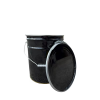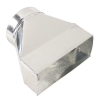- Joined
- Nov 15, 2005
- Messages
- 1,218
Well it's time for me to actually follow though on a grinding room. With my new shop deployment I want to keep the dust down from day 1! I have a space sectioned off that's about 12ft by 6-1/4ft to turn into a grinding room. While it's not quite as wide as I'd like it to be I have limitations due to an attic door.
This is the basic overview of where I'm planning to place it in the shop:

I plan on putting a door and window (for light) on the 12' wall something like this (but the window will be 24x27 and door space designed for 32 pre-hung) :

-------------------
Before I buy the materials and start the project I'm looking for some advice from all of you for features I should incorporate into the room and things to look out for. I've never had a grinding room before so this is uncharted territory.
Some things I'm thinking about:
1.) Size -> Is my space large enough (I think it is, but won't have a ton of room for expansion... With a 32'' door I probably couldn't fit a surface grinder in there... If I get acquire one. (not sure about this - The Grizzly G5963 - 6" x 12" Surface Grinder is 33'' wide so that may fit) - Right now I just have a 2x72 and disc grinder to put in there... maybe a vise stand and angle grinder work too. Also thinking I'll wheel in the buffer when I want to use it.
2.) Walls -> Behind the grinders I'm planning on using metal roof sheeting or concrete Hardie board to protect from sparks. Also considering using thick plastic stapled to the framed walls to seal the room (and make sure the grinders don't ever back up to those walls.
3.) Venting -> I guess I'll consider installing an exhaust fan that exits the building? Maybe with a box fan filtered intake for the room?
4.) Vacuum -> I don't have a metal dust collection system spaced out, but I'm assuming this would need to also fit in the room and potentially exhaust outside into a steel barrel.
-------------------
Here are some old threads I've been browsing on this topic
-------------------
I'm open to any suggestions here and would love to see pictures if anyone has a grinding room set up!
Cheers,
JKeeton
This is the basic overview of where I'm planning to place it in the shop:

I plan on putting a door and window (for light) on the 12' wall something like this (but the window will be 24x27 and door space designed for 32 pre-hung) :

-------------------
Before I buy the materials and start the project I'm looking for some advice from all of you for features I should incorporate into the room and things to look out for. I've never had a grinding room before so this is uncharted territory.
Some things I'm thinking about:
1.) Size -> Is my space large enough (I think it is, but won't have a ton of room for expansion... With a 32'' door I probably couldn't fit a surface grinder in there... If I get acquire one. (not sure about this - The Grizzly G5963 - 6" x 12" Surface Grinder is 33'' wide so that may fit) - Right now I just have a 2x72 and disc grinder to put in there... maybe a vise stand and angle grinder work too. Also thinking I'll wheel in the buffer when I want to use it.
2.) Walls -> Behind the grinders I'm planning on using metal roof sheeting or concrete Hardie board to protect from sparks. Also considering using thick plastic stapled to the framed walls to seal the room (and make sure the grinders don't ever back up to those walls.
3.) Venting -> I guess I'll consider installing an exhaust fan that exits the building? Maybe with a box fan filtered intake for the room?
4.) Vacuum -> I don't have a metal dust collection system spaced out, but I'm assuming this would need to also fit in the room and potentially exhaust outside into a steel barrel.
-------------------
Here are some old threads I've been browsing on this topic
Hey yall, I'm going to be moving to a new shop soon... and I'm going to have the space to frame up a plastic enclosed "grinding room." I'd love to hear and see how some of yall did yours! Any tips and tricks would be greatly appreciated.
This is what I'm looking for:
- Sweet Pictures of your Grinding Room if you have one!
- What tools you have in or think should be in your grinding room? (grinder, buffer, drill press?, welder?, just wondering yall's thoughts on this one)
- Is it worth cutting a hole in the wall for an exhaust fan? or try an internal air filter?
- Any...
This is what I'm looking for:
- Sweet Pictures of your Grinding Room if you have one!
- What tools you have in or think should be in your grinding room? (grinder, buffer, drill press?, welder?, just wondering yall's thoughts on this one)
- Is it worth cutting a hole in the wall for an exhaust fan? or try an internal air filter?
- Any...
- J. Keeton
- Replies: 18
- Forum: Shop Talk - BladeSmith Questions and Answers
I currently do not have a grinder room in my shop but have been contemplating getting one done. I work sitting down because that is how I got used to working and now have a hard time being steady working on my feet. All of my equipment is right around my work table and I can move from one machine to another in now time but I battle with the dust constantly. The question to you all that have a grinder room is do you find it to be a lot of going back and forth from one area of your shop to another and is it worth it for you. My concern is that I'm a full time maker and time is money for me...
- ep3757
- Replies: 10
- Forum: Around the Grinder
Hello,
Long time lurker, first time posting. I posed this question over at Iforgeiron, but I figured I’d get more traction here.
So i’ve about had enough of the constant layer of metal dust on EVERYTHING around my small shop. Ive cleared a small corner to build a simple grinding room (closet in this case) and I have a few questions for those of you with such luxury’s.
What is the smallest area you’d feel comfortable with around your grinder? I’ve cleared about a 5x5’ area in a corner, and that’s about the max I could go. Is hoping to squeeze a 2x72 and myself in there a bad idea? I...
Long time lurker, first time posting. I posed this question over at Iforgeiron, but I figured I’d get more traction here.
So i’ve about had enough of the constant layer of metal dust on EVERYTHING around my small shop. Ive cleared a small corner to build a simple grinding room (closet in this case) and I have a few questions for those of you with such luxury’s.
What is the smallest area you’d feel comfortable with around your grinder? I’ve cleared about a 5x5’ area in a corner, and that’s about the max I could go. Is hoping to squeeze a 2x72 and myself in there a bad idea? I...
- ItsNick
- Replies: 9
- Forum: Shop Talk - BladeSmith Questions and Answers
Hey Gang,
I'm currently remodeling my new shop and I've decided that part of the remodel is going to include building a grinding room. I'd like to put my current grinding equipment (2x27, surface grinder) along with a horizontal grinder and maybe one other future purchase.
I don't want to make it too big, I'm thinking around 10'-12' x 15'-20', but I haven't measured this out yet. I'm redoing my floor and now that I have everything on one side of my shop, I'm going to use some masking tape to lay it out.
My goal is to isolate dust, in my last shop dust got into everything.
So if you...
I'm currently remodeling my new shop and I've decided that part of the remodel is going to include building a grinding room. I'd like to put my current grinding equipment (2x27, surface grinder) along with a horizontal grinder and maybe one other future purchase.
I don't want to make it too big, I'm thinking around 10'-12' x 15'-20', but I haven't measured this out yet. I'm redoing my floor and now that I have everything on one side of my shop, I'm going to use some masking tape to lay it out.
My goal is to isolate dust, in my last shop dust got into everything.
So if you...
- Augus7us
- Replies: 14
- Forum: Shop Talk - BladeSmith Questions and Answers
-------------------
I'm open to any suggestions here and would love to see pictures if anyone has a grinding room set up!
Cheers,
JKeeton




